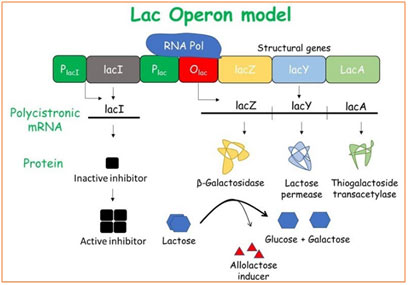What is Operon?
The concept of the operon was presented by Jacob and Monod in 1961. In microorganisms and archaea bacteria, structural proteins with associated features are usually inscribed together within the genome in a block called an operon.
Operon is defined as a segment of a DNA strand including:
- Structure Genes
A cluster of several structural genes, which carries the codons which can be translated into proteins.
- Operator genes
One operator gene has overall control over the process of translation.
- Regulator gene
A third gene called the regulator gene lies often at a distance from the operator gene on the same strand of DNA. Regulator gene transcribes m-RNA which synthesizes “repressor protein” molecules that control the transcription.
- P site (promoter site)
It is situated in between the operator gene and regulator gene.
Lactose (Lac) operon

The “lac operon” is an inducible catabolic operon of E. coli. It consists of:
- Structural genes of lac operon
It has three structural genes ‘Z’, ‘Y’, and ‘A’. Code respectively for “β-galactosidase”, “galactoside permease” and “thiogalactoside transacetylase”.
Functions:
- β-galactosidase: hydrolyzes lactose (β-galactoside) to galactose and glucose.
- Permease: responsible for the transportation of lactose into the cell.
- Acetylase: coded by ‘A’ genetics is not known properly.
The structural genes Z, Y, and A transcribe to create a single huge m-RNA with 3 independent translation units for the synthesis of the 3 distinctive enzymes. Such an m-RNA coding for more than one protein is called “polycistronic m-RNA” which is characteristic in prokaryotes.
Negative Control of the lac Operon
The protein that prevents transcription of the lac operon is a tetramer with four identical subunits called lac repressors. The lac repressor is inscribed by the lacI gene, located upstream of the lac operon, and has its own promoter.
Expression of the lacI gene is not managed as well as very reduced degrees of the lac repressor are continuously manufactured. Genes whose expression is not regulated are called constitutive genes.
In the absence of lactose, the lac repressor blocks the expression of the lac operon by binding to the DNA at a site, called the operator that is downstream of the promoter and also upstream of the transcriptional initiation site.
The operator contains a specific nucleotide series that is acknowledged by the repressor which binds extremely tightly, physically blocking (suffocating) the initiation of transcription.
Positive Control of the lac Operon
Although lactose can generate the expression of the lac operon, the degree of expression is really reduced. The reason for this is that the lac operon undergoes catabolite suppression or the reduced expression of genetics prompted by growth in the presence of glucose.
Glucose is really easily metabolized so is the preferred fuel source over lactose, hence it makes sense to avoid the expression of lac operon when glucose exists.

Role of Catabolic Gene Activator Protein (CAP)
Catabolite gene activator protein is a dimer that serves as a positive regulator of lots of catabolic operons like the “lac operon” in E. coli. Accessory of “RNA polymerase” to the promotor site needs the presence of CAP bound to cAMP.
The absence of glucose in the cell activates “adenylate cyclase” which catalyzes the synthesis of cAMP from ATP. The later binds to CAP to create a “CAP – Camp complex”. Unlike free CAP, this complicated binds to the promotor site immediately.
This boosts the initiation of transcription of the “Lac operon” structural genes in the lack of repressors. The binding of the “CAP-cAMP complex” to promotor improves “RNA polymerase” activity.
On the other hand, the presence of glucose lowers the intracellular cAMP. Because of decreased levels of cAMP, the development of “CAP-cAMP complex” to p-site is negligible and the transcription does not happen. Hence, sugar disrupts the expression of “Lac operon” by depleting the cAMP level.

